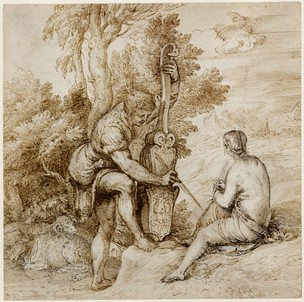In the wonderful L'Orangerie Gallery in Paris
are two oval rooms filled with waterlily paintings (Nympheas in French) designed by Claude Monet explicitly for those spaces.

He expressly asked for the natural light to flood in through the ceilings in order to reinforce his
notion that the paintings represented light moving from east to west during the course of two days.
ROOM 1

The paintings were conceived of as an ""illusion of an endless whole, of a wave with no horizon and no shore," as Monet put it.

Here you can see how one room leads seamlessly to the next so that the viewer feels the flow of the
water and the paintings' color from one oval to the other, certainly the wave that Monet was describing.
When we look closely at any of the curved panels (4 in each room), we become aware of the
lack of horizon in all of them.
The viewer latches onto the white waterlilies as a way of grounding him/her/self in the vast expanse of the ponds depicted.
The viewer latches onto the white waterlilies as a way of grounding him/her/self in the vast expanse of the ponds depicted.
There are actually three different surfaces that Monet conveys in these curved waterscapes:
1) SURFACE OF THE WATER: where the white waterlilies grow
2) DEPTHS OF THE WATER: where the dark green reeds grow
The waterlilies hover between the sky and the depths of the water in a fairy-tale world of
turquoise and deep blue and white. The viewer floats, too, from panel to panel, suspended from gravity even when sitting to look at the paintings, so powerful is the sensation of being freed from the
earth. Monet's desire to convey infinity is accomplished beautifully in these two interwoven rooms of water. His prescience about the quality of space travel is here.
Just as we become aware of the suspension of gravity, the weightlessness of the universe in
these rooms of color, we are also made aware at the same time of the changing nature of light over the course of various days.
Thus, the light turquoise and pink of early morning:
and the amber sunset tones of dusk when the light starts to fade:Monet had been working on paintings of his water-lily pond in Giverny from the 1890's, soon after he had moved to the property west of Paris. But in 1918 he realized that the France as a country needed to recover from the Great War of 1914-18, and as part of the healing process, he offered to paint these rooms for the nation. With the help of Prime Minister Clemenceau, who had become a friend of Monet's, the project was carried out over many years, and was finally installed properly in 1927,
months after the artist's death in 1926. Like Beethoven, whose deafness did not keep him from hearing inside his brain the music he composed, Monet did not have to see these paintings completely in place to know the effect that they would have on the viewers of them.
The sheer visual pleasure that he produces with the combinations of pinks and greens and deep purples and blues is as nourishing and healing as he intended them to be.
The viewer can submerse him/herself in the water as if swimming, or can smell the fragrance of the lilies or feel the soft touch of their petals.
The viewer can fly among the clouds reflected on the pond's surface and become one with the colors in a sky that knows no national boundaries or languages.
While Paris as a city during Monet's lifetime (1840-1926) is growing as an urban center with the improvements to avenues, building facades, and park life begun during Haussmann's renovations under Napoleon III, the life of the countryside is more appealing to Monet. He continues to paint
a plein air, out of doors, from the 1890's until the end of his life in his rural setting in Giverny, about 50 miles outside of Paris. His awareness of the nurturing needed for the nation to recover from war,
though, enabled him to transport, through oil paint on canvas, his garden in Giverny, into the very heart of the capital city. Monet's garden walk continues Haussmann's idea about urban living that every city dweller needs to be within 10 minutes of a park to live happily in a city. But Monet goes beyond that and uplifts the urban inhabitant and city visitor to a garden where belief in reality is suspended in a world of color and light, flowers, and clouds, air, and water.
His notion of infinity is one of continuous nurturing through beauty. The movement of light through
 two days repeats without end from one oval to the other and the viewer is transported with the light
two days repeats without end from one oval to the other and the viewer is transported with the lightover,
in, and
above the water.






























































